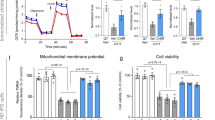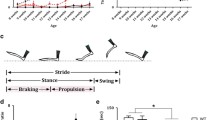Abstract
Sirtuin 1 (SIRT1) is a nicotinamide adenine dinucleotide (NAD+)-dependent lysine deacetylase that regulates longevity and enhances mitochondrial metabolism. Both activation and inhibition of SIRT1 were previously shown to ameliorate neuropathological mechanisms in Huntington’s disease (HD), a neurodegenerative disease that selectively affects the striatum and cortex and is commonly linked to mitochondrial dysfunction. Thus, in this study, we tested the influence of resveratrol (RESV, a SIRT1 activator) versus nicotinamide (NAM, a SIRT1 inhibitor) in counteracting mitochondrial dysfunction in HD models, namely striatal and cortical neurons isolated from YAC128 transgenic mice embryos, HD human lymphoblasts, and an in vivo HD model. HD cell models displayed a deregulation in mitochondrial membrane potential and respiration, implicating a decline in mitochondrial function. Further studies revealed decreased PGC-1α and TFAM protein levels, linked to mitochondrial DNA loss in HD lymphoblasts. Remarkably, RESV completely restored these parameters, while NAM increased NAD+ levels, providing a positive add on mitochondrial function in in vitro HD models. In general, RESV decreased while NAM increased H3 acetylation at lysine 9. In agreement with in vitro data, continuous RESV treatment for 28 days significantly improved motor coordination and learning and enhanced expression of mitochondrial-encoded electron transport chain genes in YAC128 mice. In contrast, high concentrations of NAM blocked mitochondrial-related transcription, worsening motor phenotype. Overall, data indicate that activation of deacetylase activity by RESV improved gene transcription associated to mitochondrial function in HD, which may partially control HD-related motor disturbances.





Similar content being viewed by others
References
Tanner KG, Landry J, Sternglanz R, Denu JM (2000) Silent information regulator 2 family of NAD-dependent histone/protein deacetylases generates a unique product, 1-O-acetyl-ADP-ribose. Proc Natl Acad Sci U S A 97:14178–14182. doi:10.1073/pnas.250422697
Choudhary C, Weinert BT, Nishida Y, et al. (2014) The growing landscape of lysine acetylation links metabolism and cell signalling. Nat Rev Mol Cell Biol 15:536–550. doi:10.1038/nrm3841
Gil JM, Rego AC (2008) Mechanisms of neurodegeneration in Huntington’s disease. Eur J Neurosci 27:2803–2820. doi:10.1111/j.1460-9568.2008.06310.x
Naia L, Ribeiro MJ, Rego AC (2011) Mitochondrial and metabolic-based protective strategies in Huntington’s disease: the case of creatine and coenzyme Q. Rev Neurosci 23:13–28
Ferreira IL, Cunha-Oliveira T, Nascimento MV, et al. (2011) Bioenergetic dysfunction in Huntington’s disease human cybrids. Exp Neurol 231:127–134. doi:10.1016/j.expneurol.2011.05.024
Silva AC, Almeida S, Laço M, et al. (2013) Mitochondrial respiratory chain complex activity and bioenergetic alterations in human platelets derived from pre-symptomatic and symptomatic huntington’s disease carriers. Mitochondrion 13:801–809. doi:10.1016/j.mito.2013.05.006
Naia L, Ferreira IL, Cunha-Oliveira T, et al. (2015) Activation of IGF-1 and insulin signaling pathways ameliorate mitochondrial function and energy metabolism in Huntington’s disease human lymphoblasts. Mol Neurobiol 51:331–348. doi:10.1007/s12035-014-8735-4
Parker JA, Arango M, Abderrahmane S, et al. (2005) Resveratrol rescues mutant polyglutamine cytotoxicity in nematode and mammalian neurons. Nat Genet 37:349–350. doi:10.1038/ng1534
Pallos J, Bodai L, Lukacsovich T, et al. (2008) Inhibition of specific HDACs and sirtuins suppresses pathogenesis in a Drosophila model of Huntington’s disease. Hum Mol Genet 17:3767–3775. doi:10.1093/hmg/ddn273
Naia L, Rego AC (2015) Sirtuins: double players in Huntington’s disease. Biochim Biophys Acta - Mol Basis Dis 1852:2183–2194. doi:10.1016/j.bbadis.2015.07.003
Jiang M, Wang J, Fu J, et al. (2012) Neuroprotective role of Sirt1 in mammalian models of Huntington’s disease through activation of multiple Sirt1 targets. Nat Med 18:153–158. doi:10.1038/nm.2558
Tulino R, Benjamin AC, Jolinon N, et al. (2016) SIRT1 activity is linked to its brain region-specific phosphorylation and is impaired in Huntington’s disease mice. PLoS One 11:e0145425. doi:10.1371/journal.pone.0145425
Ho DJ, Calingasan NY, Wille E, et al. (2010) Resveratrol protects against peripheral deficits in a mouse model of Huntington’s disease. Exp Neurol 225:74–84. doi:10.1016/j.expneurol.2010.05.006
Price NL, Gomes AP, Ling AJY, et al. (2012) SIRT1 is required for AMPK activation and the beneficial effects of resveratrol on mitochondrial function. Cell Metab 15:675–690. doi:10.1016/j.cmet.2012.04.003
Hubbard BP, Gomes AP, Dai H, et al. (2013) Evidence for a common mechanism of SIRT1 regulation by allosteric activators. Science 339:1216–1219. doi:10.1126/science.1231097
Borra MT, Smith BC, Denu JM (2005) Mechanism of human SIRT1 activation by resveratrol. J Biol Chem 280:17187–17195. doi:10.1074/jbc.M501250200
Howitz K, Bitterman J, Cohen H (2003) Small molecule activators of sirtuins extend Saccharomyces cerevisiae lifespan. Nature 425:191–196. doi:10.1038/nature01965.1
Lagouge M, Argmann C, Gerhart-Hines Z, et al. (2006) Resveratrol improves mitochondrial function and protects against metabolic disease by activating SIRT1 and PGC-1alpha. Cell 127:1109–1122. doi:10.1016/j.cell.2006.11.013
Pearson KJ, Baur JA, Lewis KN, et al. (2008) Resveratrol delays age-related deterioration and mimics transcriptional aspects of dietary restriction without extending life span. Cell Metab 8:157–168. doi:10.1016/j.cmet.2008.06.011
Jackson MD, Schmidt MT, Oppenheimer NJ, Denu JM (2003) Mechanism of nicotinamide inhibition and transglycosidation by Sir2 histone/protein deacetylases. J Biol Chem 278:50985–50998. doi:10.1074/jbc.M306552200
Scholz C, Weinert BT, Wagner SA, et al. (2015) Acetylation site specificities of lysine deacetylase inhibitors in human cells. Nat Biotech 33:415–423. doi:10.1038/nbt.3130
Hathorn T, Snyder-Keller A, Messer A (2011) Nicotinamide improves motor deficits and upregulates PGC-1α and BDNF gene expression in a mouse model of Huntington’s disease. Neurobiol Dis 41:43–50. doi:10.1016/j.nbd.2010.08.017
Ghosh S, Feany MB (2004) Comparison of pathways controlling toxicity in the eye and brain in drosophila models of human neurodegenerative diseases. Hum Mol Genet 13:2011–2018. doi:10.1093/hmg/ddh214
Schmeisser K, Mansfeld J, Kuhlow D, et al. (2013) Role of sirtuins in lifespan regulation is linked to methylation of nicotinamide. Nat Chem Biol 9:693–700. doi:10.1038/nchembio.1352
Naia L, Ribeiro M, Rodrigues J, et al. (2016) Insulin and IGF-1 regularize energy metabolites in neural cells expressing full-length mutant huntingtin. Neuropeptides:1–9. doi:10.1016/j.npep.2016.01.009
Slow EJ, van Raamsdonk J, Rogers D, et al. (2003) Selective striatal neuronal loss in a YAC128 mouse model of Huntington disease. Hum Mol Genet 12:1555–1567. doi:10.1093/hmg/ddg169
Berta GN, Salamone P, Sprio AE, et al. (2010) Chemoprevention of 7,12-dimethylbenz[a]anthracene (DMBA)-induced oral carcinogenesis in hamster cheek pouch by topical application of resveratrol complexed with 2-hydroxypropyl-beta-cyclodextrin. Oral Oncol 46:42–48. doi:10.1016/j.oraloncology.2009.10.007
Tiwari G, Tiwari R, Rai AK (2010) Cyclodextrins in delivery systems: applications. J Pharm Bioallied Sci 2:72–79. doi:10.4103/0975-7406.67003
Venegas V, Halberg MC (2012) Measurement of mitochondrial DNA copy number. Methods Mol Biol 837:327–335. doi:10.1007/978-1-61779-504-6_22
Scaduto RC, Grotyohann LW (1999) Measurement of mitochondrial membrane potential using fluorescent rhodamine derivatives. Biophys J 76:469–477. doi:10.1016/S0006-3495(99)77214-0
Vaquero A, Scher M, Lee D, et al. (2004) Human SirT1 interacts with histone H1 and promotes formation of facultative heterochromatin. Mol Cell 16:93–105. doi:10.1016/j.molcel.2004.08.031
Pruitt K, Zinn RL, Ohm JE, et al. (2006) Inhibition of SIRT1 reactivates silenced cancer genes without loss of promoter DNA hypermethylation. PLoS Genet 2:0344–0352. doi:10.1371/journal.pgen.0020040
Nakahata Y, Kaluzova M, Grimaldi B, et al. (2008) The NAD+-dependent deacetylase SIRT1 modulates CLOCK-mediated chromatin remodeling and circadian control. Cell 134:329–340. doi:10.1016/j.cell.2008.07.002
Masri S, Patel VR, Eckel-Mahan KL, et al. (2013) Circadian acetylome reveals regulation of mitochondrial metabolic pathways. Proc Natl Acad Sci 110:3339–3344. doi:10.1073/pnas.1217632110
Sassone J, Colciago C, Cislaghi G, et al. (2009) Huntington’s disease: the current state of research with peripheral tissues. Exp Neurol 219:385–397. doi:10.1016/j.expneurol.2009.05.012
Noriega LG, Feige JN, Canto C, et al. (2011) CREB and ChREBP oppositely regulate SIRT1 expression in response to energy availability. EMBO Rep 12:1069–1076. doi:10.1038/embor.2011.151
Cui L, Jeong H, Borovecki F, et al. (2006) Transcriptional repression of PGC-1alpha by mutant huntingtin leads to mitochondrial dysfunction and neurodegeneration. Cell 127:59–69. doi:10.1016/j.cell.2006.09.015
Taherzadeh-Fard E, Saft C, Akkad DA, et al. (2011) PGC-1alpha downstream transcription factors NRF-1 and TFAM are genetic modifiers of Huntington disease. Mol Neurodegener 6:32. doi:10.1186/1750-1326-6-32
Weydt P, Pineda VV, Torrence AE, et al. (2006) Thermoregulatory and metabolic defects in Huntington’s disease transgenic mice implicate PGC-1alpha in Huntington’s disease neurodegeneration. Cell Metab 4:349–362. doi:10.1016/j.cmet.2006.10.004
Ngo HB, Lovely GA, Phillips R, Chan DC (2014) Distinct structural features of TFAM drive mitochondrial DNA packaging versus transcriptional activation. Nat Commun 5:3077. doi:10.1038/ncomms4077
Van Raamsdonk JM, Pearson J, Slow EJ, et al. (2005) Cognitive dysfunction precedes neuropathology and motor abnormalities in the YAC128 mouse model of Huntington’s disease. J Neurosci 25:4169–4180. doi:10.1523/JNEUROSCI.0590-05.2005
Brandt J, Strauss ME, Larus J, et al. (1984) Clinical correlates of dementia and disability in Huntington’s disease. J Clin Neuropsychol 6:401–412. doi:10.1080/01688638408401231
Shirendeb U, Reddy AP, Manczak M, et al. (2011) Abnormal mitochondrial dynamics, mitochondrial loss and mutant huntingtin oligomers in Huntington’s disease: implications for selective neuronal damage. Hum Mol Genet 20:1438–1455. doi:10.1093/hmg/ddr024
Jiang M, Zheng J, Peng Q, et al. (2014) Sirtuin 1 activator SRT2104 protects Huntington’s disease mice. Ann Clin Transl Neurol 1:1047–1052. doi:10.1002/acn3.135
Pacholec M, Bleasdale JE, Chrunyk B, et al. (2010) SRT1720, SRT2183, SRT1460, and resveratrol are not direct activators of SIRT1. J Biol Chem 285:8340–8351. doi:10.1074/jbc.M109.088682
Baur JA, Sinclair DA (2006) Therapeutic potential of resveratrol: the in vivo evidence. Nat Rev Drug Discov 5:493–506. doi:10.1038/nrd2060
Hankes LV, Coenen HH, Rota E, et al. (1991) Effect of Huntington’s and Alzheimer’s diseases on the transport of nicotinic acid or nicotinamide across the human blood-brain barrier. AdvExpMedBiol 294:675–678
Baur JA, Pearson KJ, Price NL, et al. (2006) Resveratrol improves health and survival of mice on a high-calorie diet. Nature 444:337–342. doi:10.1038/nature05354
Panov AV, Gutekunst CA, Leavitt BR, et al. (2002) Early mitochondrial calcium defects in Huntington’s disease are a direct effect of polyglutamines. Nat Neurosci 5:731–736. doi:10.1038/nn884
Yano H, Baranov SV, Baranova OV, et al. (2014) Inhibition of mitochondrial protein import by mutant huntingtin. Nat Neurosci 17:822–831. doi:10.1038/nn.3721
Cunha-Oliveira T, Lusa I, Cristina A (2012) Consequences of mitochondrial dysfunction in Huntington’s disease and protection via phosphorylation pathways. Huntington’s Dis - Core Concepts Curr Adv. doi:10.5772/32728
Scarpulla RC (2011) Metabolic control of mitochondrial biogenesis through the PGC-1 family regulatory network. Biochim Biophys Acta 1813:1269–1278. doi:10.1016/j.bbamcr.2010.09.019
Lopes costa A, Le bachelier C, Mathieu L, et al. (2014) Beneficial effects of resveratrol on respiratory chain defects in patients’ fibroblasts involve estrogen receptor and estrogen-related receptor alpha signaling. Hum Mol Genet 23:2106–2119. doi:10.1093/hmg/ddt603
Bitterman KJ, Anderson RM, Cohen HY, et al. (2002) Inhibition of silencing and accelerated aging by nicotinamide, a putative negative regulator of yeast Sir2 and human SIRT1. J Biol Chem 277:45099–45107. doi:10.1074/jbc.M205670200
Sauve AA (2008) NAD+ and vitamin B 3 : from metabolism to therapies. J Pharmacol Exp Ther 324:883–893. doi:10.1124/jpet.107.120758.energy
Klaidman L, Morales M, Kem S, et al. (2003) Nicotinamide offers multiple protective mechanisms in stroke as a precursor for NAD+, as a PARP inhibitor and by partial restoration of mitochondrial function. Pharmacology 69:150–157. doi:10.1159/000072668
Chong ZZ, Lin SH, Li F, Maiese K (2005) The sirtuin inhibitor nicotinamide enhances neuronal cell survival during acute anoxic injury through AKT, BAD, PARP, and mitochondrial associated “anti-apoptotic” pathways. Curr Neurovasc Res 2:271–285. doi:10.2174/156720205774322584
Liu D, Gharavi R, Pitta M, et al. (2009) Nicotinamide prevents NAD+ depletion and protects neurons against excitotoxicity and cerebral ischemia: NAD+ consumption by sirt1 may endanger energetically compromised neurons. Neruomol Med 11:28–42. doi:10.1007/s12017-009-8058-1
Vang O, Ahmad N, Baile CA, et al. (2011) What is new for an old molecule? Systematic review and recommendations on the use of resveratrol. PLoS One. doi:10.1371/journal.pone.0019881
Author information
Authors and Affiliations
Corresponding author
Ethics declarations
Animals’ maintenance and procedures were performed in accordance with the protocols approved by the Ethical Commission from the Faculty of Medicine, University of Coimbra (FMUC). Euthanasia by halothane or isoflurane anesthesia and decapitation was performed according to EU guideline 86/609/EEC and Annex II of Portuguese decree-law No. 113/2013.
Funding
This work was supported by “Fundo Europeu de Desenvolvimento Regional” (FEDER) funds through the “Programa Operacional Factores de Competitividade” (COMPETE), projects reference PEst-C/SAU/LA0001/2013–2014 and UID/NEU/04539/2013; and by national funds through “Fundação para a Ciência e a Tecnologia” (FCT), projects reference PTDC/SAU-FCF/108056/2008, EXPL/BIM-MEC/2220/2013, and Mantero Belard Neuroscience prize 2013, supported by Santa Casa da Misericórdia de Lisboa (SCML), Portugal. L.N. was supported by the FCT PhD fellowship SFRH/BD/86655/2012; T.R.R. and M.N.L. were supported by the FCT postdoctoral fellowships SFRH/BPD/44246/2008 and SFRH/BPD/91811/2012, respectively; and A.M.O. was supported by the FCT technician fellowship under the research project EXPL/BIM-MEC/2220/2013, cofinanced by Programa Operacional Potencial Humano (POPH), QREN, and European Union.
Conflict of Interest
The authors declare that they have no conflict of interest.
Electronic supplementary material
ESM. 1
(PDF 2487 kb)
Rights and permissions
About this article
Cite this article
Naia, L., Rosenstock, T.R., Oliveira, A.M. et al. Comparative Mitochondrial-Based Protective Effects of Resveratrol and Nicotinamide in Huntington’s Disease Models. Mol Neurobiol 54, 5385–5399 (2017). https://doi.org/10.1007/s12035-016-0048-3
Received:
Accepted:
Published:
Issue Date:
DOI: https://doi.org/10.1007/s12035-016-0048-3




